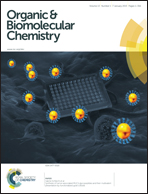Systematic methodology for the development of biocatalytic hydrogen-borrowing cascades: application to the synthesis of chiral α-substituted carboxylic acids from α-substituted α,β-unsaturated aldehydes†
Abstract
Ene-reductases (ERs) are flavin dependent enzymes that catalyze the asymmetric reduction of activated carbon–carbon double bonds. In particular, α,β-unsaturated carbonyl compounds (e.g. enals and enones) as well as nitroalkenes are rapidly reduced. Conversely, α,β-unsaturated esters are poorly accepted substrates whereas free carboxylic acids are not converted at all. The only exceptions are α,β-unsaturated diacids, diesters as well as esters bearing an electron-withdrawing group in α- or β-position. Here, we present an alternative approach that has a general applicability for directly obtaining diverse chiral α-substituted carboxylic acids. This approach combines two enzyme classes, namely ERs and aldehyde dehydrogenases (Ald-DHs), in a concurrent reductive-oxidative biocatalytic cascade. This strategy has several advantages as the starting material is an α-substituted α,β-unsaturated aldehyde, a class of compounds extremely reactive for the reduction of the alkene moiety. Furthermore no external hydride source from a sacrificial substrate (e.g. glucose, formate) is required since the hydride for the first reductive step is liberated in the second oxidative step. Such a process is defined as a hydrogen-borrowing cascade. This methodology has wide applicability as it was successfully applied to the synthesis of chiral substituted hydrocinnamic acids, aliphatic acids, heterocycles and even acetylated amino acids with elevated yield, chemo- and stereo-selectivity. A systematic methodology for optimizing the hydrogen-borrowing two-enzyme synthesis of α-chiral substituted carboxylic acids was developed. This systematic methodology has general applicability for the development of diverse hydrogen-borrowing processes that possess the highest atom efficiency and the lowest environmental impact.



 Please wait while we load your content...
Please wait while we load your content...